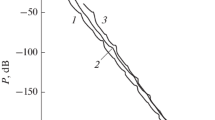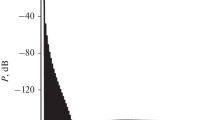Abstract
This article proposes a cost minimization approach to the problem of optimizing weighting digital windows used in classical 2-D spectral analysis. We suggest a general criterion form characterizing the 2-D spectral spreading caused by a window. Then this criterion is minimized and this results in an optimal shape of the window, extending an approach given by A. Papoulis in the case of monodimensional analog signals. We focus mainly on the minimization of a modification of the second order moment adapted to sampled signals. This leads to a natural extension of the optimal window of Papoulis to the case of 2-D digital signals. In the case of rectangular sampling, this optimal window is separable and has a simple analytical form. It is the product of two 1-D half period long cosine lobe windows. Results are also given in the case of hexagonal sampling. Other possible forms of the cost function are also discussed.
Similar content being viewed by others
References
J. Capon, “High resolution frequency—Wavenumber spectrum analysis,”Proc. IEEE, vol. 57, pp. 1408–1418, 1969.
D.E. Dudgeon and R.M. Mersereau, “Multidimensional digital signal processing,” Prentice Hall, Englewood Cliffs, NJ, 1984.
B. Gold and C.M. Rader,Digital Processing of Signals, McGraw Hill, NY, 1969.
F.J. Harris, “On the use of windows for harmonic analysis with the discrete Fourier transform,”Proc. IEEE, vol. 66, pp. 51–83, 1978.
J. Le Roux, “Spectral spreading minimization for optimal window synthesis in spectral analysis,” submitted for presentation at ICASSP'91 and IEEE trans. on ASSP.
J.H. McClellan, “The design of two-dimensional digital filters by transformations,” Proc. 7th Annual Princeton Conf. on Information Sciences and Systems, pp. 247–251, 1973.
S.L. Marple, “Digital spectral analysis with applications,” Prentice Hall, Englewood Cliffs, NJ, 1987.
R.M. Mersereau, W.F.G. Mecklenbräuker and T.F. Quatieri, “McClellan transformation for 2D digital filters: 1-Design,”IEEE Trans. on Circuits and Systems, CAS-23, pp. 405–414, 1976.
A. Papoulis, “Signal analysis,” McGraw-Hill, NY, 1978.
A. Papoulis, “Apodization for optimum imaging of smooth objects,”J. Opt. Soc. Am., vol. 62, pp. 1423–1429, 1972.
V.F. Pisarenko, “The retrieval of harmonics from a covariance function,”Geophys. J. R. Astr. Soc., vol. 33, pp. 347–366, 1973.
Author information
Authors and Affiliations
Rights and permissions
About this article
Cite this article
le Roux, J. Weighting window optimization for classical 2-D spectral analysis. Multidim Syst Sign Process 2, 9–21 (1991). https://doi.org/10.1007/BF01940469
Received:
Issue Date:
DOI: https://doi.org/10.1007/BF01940469




